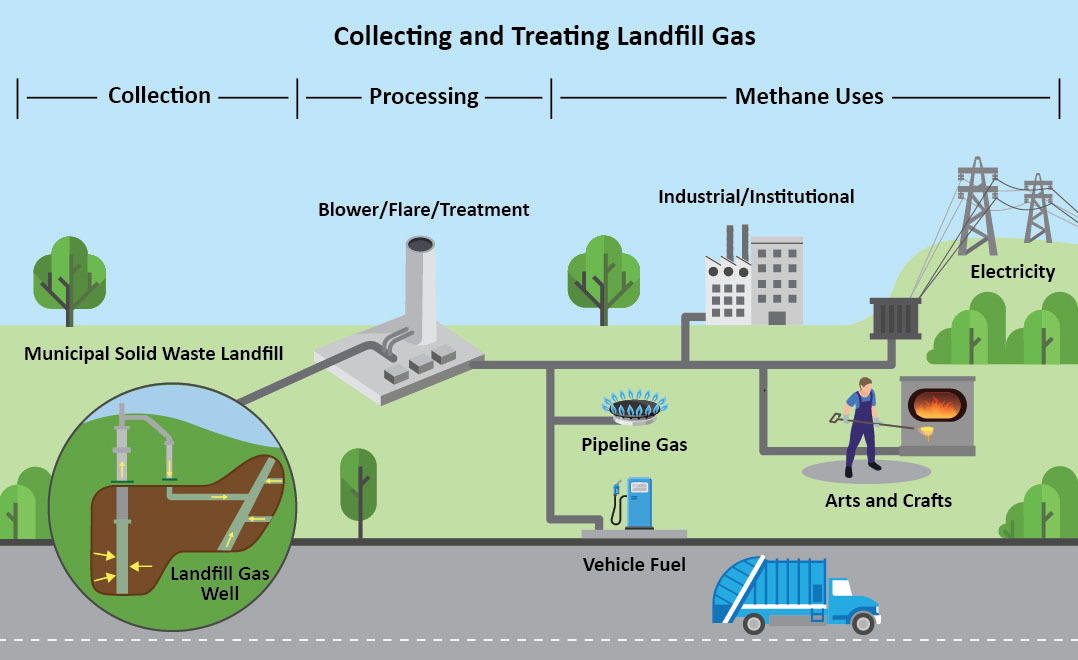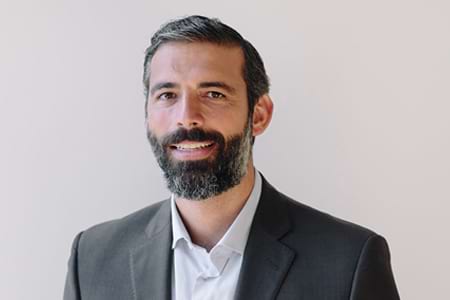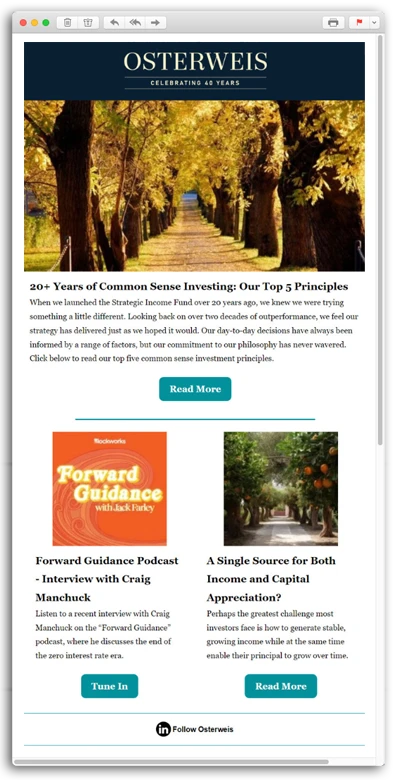Producing Cash from Trash: Renewable Natural Gas
Landfills often have a terrible reputation: smelly, polluting, and harmful to the planet. In reality, however, waste companies have proven to be strategic innovators as the regulatory framework in the U.S. has dramatically tightened over the past several decades, leading to stringent monitoring and containment practices that limit contaminants and control the siting of landfills. Recycling and composting have also expanded to account for roughly a third of the U.S. waste stream. Recent actions to ramp up production of renewable natural gas — whereby landfill owners convert landfill gas emitted by decaying landfill waste into a low-emission fuel for utilities and vehicles — further enhances the long-term sustainability of landfills while also creating a high margin, high return on capital revenue stream.
The (Strengthening) Case for Waste
We have written in the past about how attractive the North American waste industry is from an investing standpoint. Significant regulatory barriers to entry, stable demand, durable pricing power, and continued opportunity for tuck-in acquisitions have enabled prodigious and growing free cash flow generation with improving returns on capital. We think this healthy dynamic should persist for the foreseeable future.
Further enhancing the investment case for waste is an emerging opportunity to capture a high margin revenue stream that can also help reduce greenhouse gas emissions: renewable natural gas (RNG).
How RNG is Produced
Decaying municipal solid waste (i.e., garbage) in landfills generates copious amounts of harmful gases (landfill gas) comprised primarily of methane and carbon dioxide, in addition to other noxious particles. In the U.S., landfills are the third largest source of human-related methane emissions. Methane is a particularly potent greenhouse gas that traps heat in the atmosphere at 28x the rate of carbon dioxide; landfill gas can also cause unpleasant odors.
The Clean Air Act requires landfills above a certain size to build and maintain infrastructure to collect, monitor, and flare landfill gas. Flaring landfill gas typically destroys over 99% of the methane, thereby largely offsetting the most environmentally harmful component of landfill gas and neutralizing related odors.
However, rather than simply flaring the landfill gas, landfills can leverage their existing gas collection infrastructure, process it into RNG that removes the most pollutant elements of the gas through thermochemical processes like gasification, and sell the gas for use in vehicles and electric utilities. The resulting RNG is chemically identical to conventional natural gas and can be used in existing natural gas distribution networks.
Environmental Benefits of RNG
While flaring landfill gas significantly reduces the environmental harm of landfills, it may not seem obvious that processing the landfill gas into RNG has positive environmental ramifications. However, the impacts are meaningful.
RNG projects capture up to 90% of the methane emitted from landfills, depending on system design and effectiveness. The captured methane is destroyed (converted to water and the much less potent carbon dioxide) when the gas is burned to produce energy. And the use of RNG can help replace highly polluting fossil fuels like coal in electric utilities and diesel in trucks.
Economic Benefits of RNG
RNG qualifies as an advanced biofuel under the EPA’s Renewable Fuel Standard, which requires renewable fuel to be blended into transportation fuel in increasing amounts each year. This helps ensure sustained growth in demand for RNG and bolsters the market for related tax credits.
In the case of Waste Connections, the third largest waste management company in North America and a longtime holding in our core equity and income strategies, the company plans to deploy roughly $200 million of aggregate capital on RNG facilities through 2025. Waste Connections' management anticipates having roughly 12 RNG facilities in operation across its landfill portfolio generating as much as $200 million in pre-tax cash flow by 2026. As a result, management expects a very rapid payback of 2-3 years. Regulatory changes to the Renewable Fuel Standard could impact the price of RNG, so Waste Connections is taking various measures to hedge price volatility.
Importantly, capturing and processing landfill gas into RNG should help Waste Connections achieve two of its key ESG goals of driving a 40% increase in biogas recovery and achieving a 15% reduction in scope 1 and scope 2 emissions by 2035.
Benefits to the Environment and the Bottom Line
By processing landfill gas, companies like Waste Connections are helping reduce the impact of municipal solid waste (garbage) on the environment. Importantly, we believe the financial profile of RNG projects appears highly attractive, with significant cash flow generation and rapid payback. As a result, RNG should help make landfills more environmentally and financially sustainable long into the future.
Osterweis Fund Quarter-End Performance (as of 12/31/25)
| Fund | 1 MO | QTD | YTD | 1 YR | 3 YR | 5 YR | 10 YR | 15 YR | 20 YR |
INCEP (10/1/1993) |
|---|---|---|---|---|---|---|---|---|---|---|
| OSTFX | -0.79% | 3.50% | 12.87% | 12.87% | 16.21% | 7.90% | 10.31% | 9.39% | 8.01% | 10.35% |
| S&P 500 Index | 0.06% | 2.66% | 17.88% | 17.88% | 23.01% | 14.42% | 14.82% | 14.06% | 11.00% | 10.79% |
Gross expense ratio as of 3/31/25: 0.96%
Performance data quoted represent past performance; past performance does not guarantee future results. The investment return and principal value of an investment will fluctuate so that an investor’s shares, when redeemed, may be worth more or less than their original cost. Current performance of the Fund may be higher or lower than the performance quoted. Performance data current to the most recent month end may be obtained by calling shareholder services toll free at (866) 236-0050.
Rates of return for periods greater than one year are annualized.
Where applicable, charts illustrating the performance of a hypothetical $10,000 investment made at a Fund’s inception assume the reinvestment of dividends and capital gains, but do not reflect the effect of any applicable sales charge or redemption fees. Such charts do not imply any future performance. During the period noted, fee waivers or expense reimbursements were in effect for the Osterweis Fund.
The S&P 500 Index is widely regarded as the standard for measuring large cap U.S. stock market performance. The index does not incur expenses, is not available for investment, and includes the reinvestment of dividends.
References to specific companies, market sectors, or investment themes herein do not constitute recommendations to buy or sell any particular securities.
There can be no assurance that any specific security, strategy, or product referenced directly or indirectly in this commentary will be profitable in the future or suitable for your financial circumstances. Due to various factors, including changes to market conditions and/or applicable laws, this content may no longer reflect our current advice or opinion. You should not assume any discussion or information contained herein serves as the receipt of, or as a substitute for, personalized investment advice from Osterweis Capital Management.
Complete holdings of all Osterweis mutual funds (“Funds”) are generally available ten business days following quarter end. Holdings and sector allocations may change at any time due to ongoing portfolio management. Fund holdings as of the most recent quarter end are available here: Osterweis Fund
Opinions expressed are those of the author, are subject to change at any time, are not guaranteed and should not be considered investment advice.
Mutual fund investing involves risk. Principal loss is possible. The Osterweis Fund may invest in medium and smaller sized companies, which involve additional risks such as limited liquidity and greater volatility. The Fund may invest in foreign and emerging market securities, which involve greater volatility and political, economic and currency risks and differences in accounting methods. These risks may increase for emerging markets. The Fund may invest in Master Limited Partnerships, which involve risk related to energy prices, demand and changes in tax code. The Fund may invest in debt securities that are un-rated or rated below investment grade. Lower-rated securities may present an increased possibility of default, price volatility or illiquidity compared to higher-rated securities. Investments in debt securities typically decrease in value when interest rates rise. This risk is usually greater for longer-term debt securities.
The Osterweis Funds are available by prospectus only. The Funds’ investment objectives, risks, charges and expenses must be considered carefully before investing. The summary and statutory prospectuses contain this and other important information about the Funds. You may obtain a summary or statutory prospectus by calling toll free at (866) 236-0050, or by visiting www.osterweis.com/statpro. Please read the prospectus carefully before investing to ensure the Fund is appropriate for your goals and risk tolerance.
Cash flow measures the cash generating capability of a company by adding non-cash charges (e.g. depreciation) and interest expense to pretax income.
Osterweis Capital Management is the adviser to the Osterweis Funds, which are distributed by Quasar Distributors, LLC. [OCMI-517527-2024-03-22]



